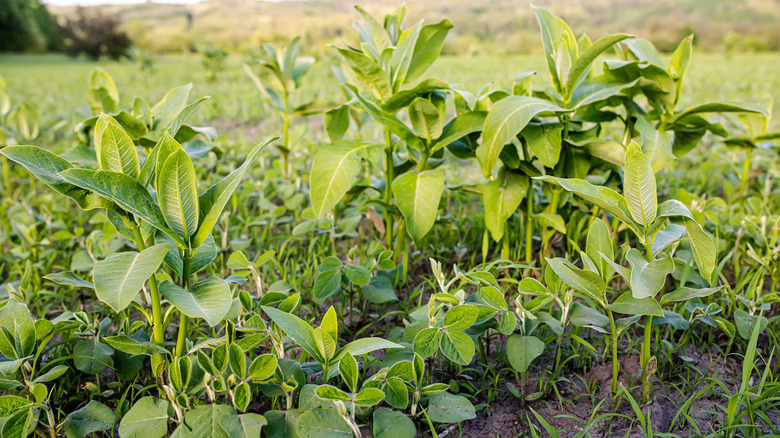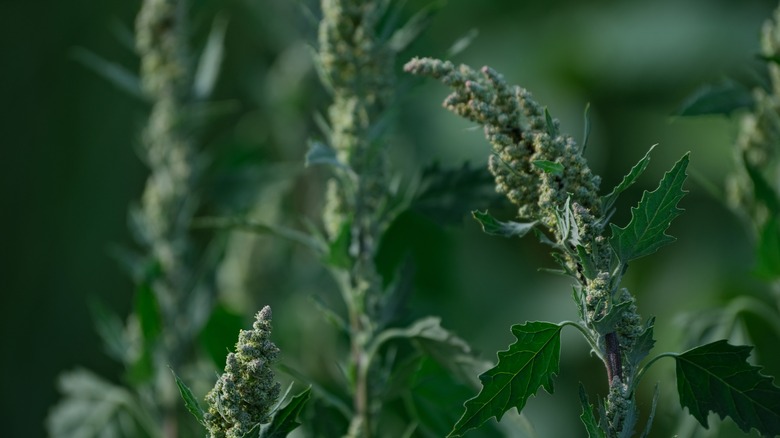The Best Way To Prevent Lambsquarters Weeds From Growing Wild In Your Garden
If you've noticed lambsquarters infiltrating your garden, swift action is your best defense to prevent it from overpowering your lawn. This common weed, known for its rapid growth and fierce competition with other plants, can swiftly transform from a minor nuisance to a major issue. Capable of growing up to 6 feet tall without intervention, lambsquarters is a resilient adversary that thrives in various environments. Whether on lawns, on farms, or along roadsides, its presence poses a common challenge for gardeners and farmers. A comprehensive approach, incorporating mulching, hoeing, and selective herbicide use, is your strongest weapon against this invasive weed. However, the success of your strategy hinges on your ability to identify this foe.
Recognizing lambsquarters is crucial for its management, and it's identifiable by several distinct characteristics. The leaves, with their unique goosefoot shape, are the first clue. These leaves are not just any green; they're covered in a fine, powdery substance that gives them a frosted, matte look, making the plant stand out among its peers.
As lambsquarters matures, it proudly displays small green flowers that cluster together, further assisting in its identification. These flowers may be inconspicuous at first glance, but they play a vital role in the plant's life cycle, leading to the abundant seed production that makes lambsquarters so formidable. The stem of the plant, often reddish-purple at the base, supports the sturdy structure and rapid growth of lambsquarters. Now that you know what it looks like, it's time to learn how to get rid of this weed.
Controlling lambsquarters
In its initial growth phases, you can control lambsquarters with physical techniques, including using a hoe or manually pulling the weeds from the ground. Applying mulch, such as black plastic, to your garden is another option. This strategy works to obstruct sunlight, which is crucial for the weed's seed germination process. However, as mentioned earlier, getting rid of this weed with herbicides is proven to be the most effective, especially for growing plants. This means getting the timing and choice of product right. The golden rule? Hit the weeds with herbicide sprays when they're still young, ideally before they stretch beyond 3 inches tall. At this stage, the plants are most vulnerable, and the herbicide can do its job most effectively.
The effectiveness of your treatment depends not just on the size and maturity of the lambsquarters but also on the surrounding environmental conditions. If you're dealing with a large weed infestation on crops such as corn, choose herbicides designed for the specific crops you're cultivating. This offers a targeted approach to managing lambsquarters. In particular, herbicides that contain dicamba have shown to be especially adept at curbing this weed in its early growth phases.
Yet it's crucial to be aware that some varieties of common lambsquarters across North America have outsmarted certain types of herbicides, notably those in the ALS-inhibitor and triazine categories. This adaptability serves as a stark reminder of the importance of adopting a holistic approach to weed management.
Managing lambsquarters' seed production
When you're up against lambsquarters in your garden, knowing how to handle them with herbicides is just part of the battle. It would help if you also kept an eye out for where the seeds settle. Each of these plants can produce more than 72,000 seeds. And these seeds don't just stay put; they can catch lifts on everything from cars and tractors to the soles of your shoes, spreading far beyond their original spot. Even more fascinating, these seeds can make it through the digestive systems of animals like cows and sheep and come out the other side, ready to grow anew in a different location.
But here's where it gets even trickier. Not all of these seeds sprout at once. Some can hang out in the soil, dormant for ages — we're talking years or even decades — before deciding to grow. This means you might think you've cleared them all out, only to find new plants sprouting up out of nowhere, especially after you've been working the soil, which brings these dormant seeds up to the surface, where they like it best.
Yet there's a bit of good news. If there's a drought, lambsquarters seeds don't produce as much. This can give you a bit of a break in your efforts to control them. So while it might seem like a daunting task to keep these prolific seeders in check, understanding their growth and survival strategies can help you stay one step ahead in the gardening game.


